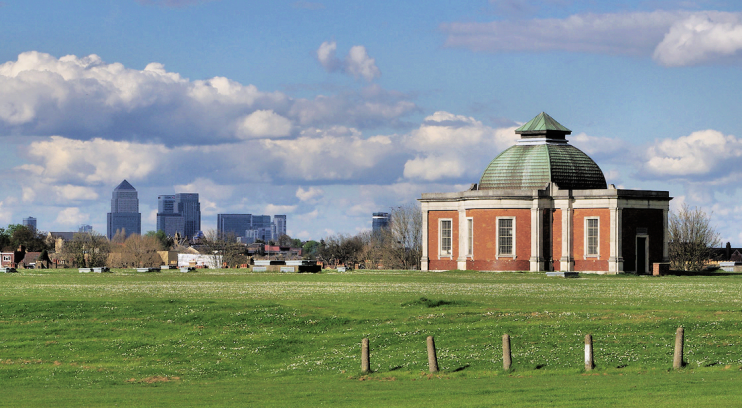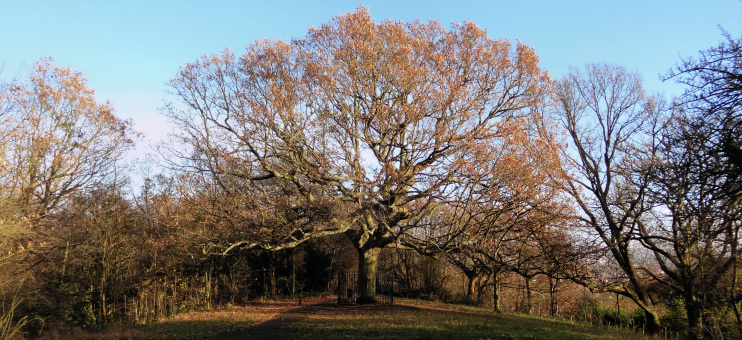Honor Oak
Honor Oak, Southwark/Lewisham
A hilly, socially diverse locality situated between Nunhead and Forest Hill

Rising to about 300 feet (just above 90 metres), One Tree Hill has been claimed as the site of Boudicca’s defeat by the Roman general Suetonius Paulinus, but this almost certainly occurred in the south Midlands.
Elizabeth I is said to have picnicked beneath the hill’s crowning oak on May Day 1602. The story is of questionable authenticity but, unlike other such tales, it seems relatively likely to be true. Either way, it is highly doubtful that the queen got drunk and knighted the tree, which has been suggested as the reason why it became known as the Oak of Honor (an old spelling of ‘honour’). In fact, the tree probably marked the southern boundary of the honour of Gloucester’s Camberwell estate.
The present-day Honor Oak Road was the original ‘Forest Hill’, deforested in the 1780s and laid out with homes for prosperous Londoners. A few of these late-Georgian homes survive to the present day, as do some early Victorian Italianate villas.
In the 1790s the East India Company set up a semaphore position on One Tree Hill (often then known as Oak of Honor Hill) to signal the arrival of its ships in the Thames. The position was commandeered by the government during the time of the Napoleonic threat.
Camberwell cemetery board laid out the burial ground now called Camberwell Old Cemetery on Forest Hill Road in 1855–6.
Honor Oak station opened in 1865 on the Crystal Palace and South London Junction Railway, stimulating housebuilding for the middle classes.
The church of St Augustine, Honor Oak Park, was built in 1873 and (presumably unconnectedly) the Oak of Honor was destroyed by a lightning strike a few years later.
In 1896 a private golf club enclosed One Tree Hill, prompting an ‘agitation’ lasting several years, which was said to have drawn 10,000 or more demonstrators on some days.

Camberwell council eventually bought the hill for £6,000 and opened it to the public in 1905, when a new Oak of Honor (shown in the photo above) was planted at the summit. The slopes of the hill are wildly wooded and the park is one of the hidden gems of south London.
Europe’s largest underground reservoir was constructed in 1901–9 on a site formerly filled with sloping cricket pitches. Its four brick-lined tanks can hold up to 56 million gallons of water, pumped here from the treatment centre at Hampton. Beechcroft Reservoir’s flat, grassy roof and valve house is shown in the photograph at the top of the page.* Click here for a Bing bird’s eye view of the church-like pumping station and the (slightly crazy) Aquarius golf course, which is laid out above and around the reservoir.
Camberwell New Cemetery opened in 1927. Most of the site had previously been a golf course and for several decades the Honor Oak and Forest Hill golf club continued to use the ever-diminishing part that was not taken by the expanding cemetery.
Honor Oak crematorium and its garden of remembrance opened in the north-east corner of the cemetery in 1939.
Some of the land originally designated for burials has never been used for the purpose (though the possibility remains that it eventually will be) and is presently a sports and recreation ground.
The Honor Oak estate was a major development of the late 1920s and early 1930s by the London County Council, with 27 brown-brick blocks of flats covering 25 acres. The estate, which is really more in Brockley than Honor Oak proper, is located near the top-right corner of the map below.
Honor Oak station and its line were closed in 1954. In the mid-1970s the Greater London Council built more housing to the west of the Honor Oak estate, where the railway line had run.
What was once the LCC’s Honor Oak school (and later Waverley school) became the Harris Girls’ Academy, East Dulwich in 2006.
Legendary London footballer Ian Wright lived on the Honor Oak Estate for much of his childhood.
Postal districts: SE23, SE22 and SE4
Further reading: John Nisbet, The Story of the One Tree Hill Agitation, with a Short Sketch of the History of Honor Oak Hill, Michael Counsell, 1997
Twitter: SE23Life
See also: Honor Oak Park and Newlands
